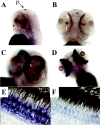Light stimulates a transducin-independent increase of cytoplasmic Ca2+ and suppression of current in cones from the zebrafish mutant nof
- PMID: 12533607
- PMCID: PMC6741873
- DOI: 10.1523/JNEUROSCI.23-02-00470.2003
Light stimulates a transducin-independent increase of cytoplasmic Ca2+ and suppression of current in cones from the zebrafish mutant nof
Abstract
Transducins couple visual pigments to cGMP hydrolysis, the only recognized phototransduction pathway in vertebrate photoreceptors. Here we describe a zebrafish mutant, no optokinetic response f(w21) (nof), with a nonsense mutation in the gene encoding the alpha subunit of cone transducin. Retinal morphology and levels of phototransduction enzymes are normal in nof retinas, but cone transducin is undetectable. Dark current in nof cones is also normal, but it is insensitive to moderate intensity light. The nof cones do respond, however, to bright light. These responses are produced by a light-stimulated, but transducin-independent, release of Ca2+ into the cone cytoplasm. Thus, in addition to stimulating transducin, light also independently induces release of Ca2+ into the photoreceptor cytoplasm.
Figures








References
-
- Arslan P, Di Virgilio F, Beltrame M, Tsien RY, Pozzan T. Cytosolic Ca2+ homeostasis in Ehrlich and Yoshida carcinomas. A new, membrane-permeant chelator of heavy metals reveals that these ascites tumor cell lines have normal cytosolic free Ca2+. J Biol Chem. 1985;260:2719–2727. - PubMed
-
- Barthel LK, Raymond PA. In situ hybridization studies of retinal neurons. Methods Enzymol. 2000;316:579–590. - PubMed
-
- Branchek T. The development of photoreceptors in the zebrafish, brachydanio rerio. II. Function. J Comp Neurol. 1984;224:116–122. - PubMed
Publication types
MeSH terms
Substances
Grants and funding
LinkOut - more resources
Full Text Sources
Other Literature Sources
Molecular Biology Databases
Miscellaneous
